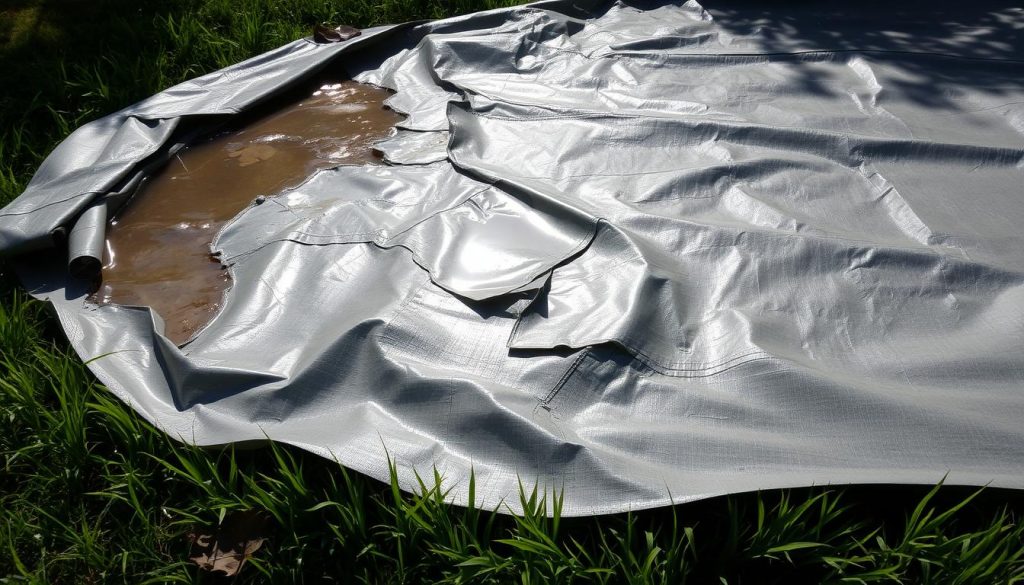
Trees are the top cause of pool cover failure. Pool owners use covers to shield pools from debris, sun, and contaminants. However, leaks and water infiltration can reduce their effectiveness.
We’ll explore common causes of pool cover leaks and factors affecting water seepage. Understanding these issues helps prevent water seepage and protects your investment in waterproof or water-resistant covers.
Common Causes of Pool Cover Leaks
Pool cover maintenance is vital for protecting your investment. Leaks can lead to water damage and costly repairs. Let’s explore common causes of pool cover leaks and prevention methods.

Pin Hole Leaks Along Creases
Tiny holes often form along creases where covers were folded during storage. These pin holes allow water to seep through the cover. Water usually leaks up to the surface, especially with larger holes.
Weak Spots in the Cover Material
Pool cover material may degrade over time, creating weak spots. These areas are more likely to tear and cause water seepage. Regular inspections can help identify weak spots early on.
Damaged or Deflated Pool Pillows
Pool pillows protect covers from water accumulation and damage. When damaged or deflated, they can’t handle rain, snow, or ice buildup. This extra weight can tear the cover, increasing the risk of water damage.
According to industry experts, using cover pumps regularly on solid pool covers is recommended to remove water, preventing potential tearing and extending the life of your pool cover.
To reduce the risk of leaks from damaged pool pillows:
- Inspect your pool pillows regularly for signs of wear or damage
- Replace damaged or deflated pillows promptly
- Ensure proper installation of pool pillows before covering your pool
- Consider using multiple pillows for larger pools or areas prone to heavy precipitation
Understanding these leak causes helps improve your cover’s water absorption. It also protects your pool from potential water damage. Proper maintenance can prevent costly repairs and ensure a smoother pool opening.
Factors Affecting Water Seepage Through Pool Covers
Pool cover maintenance is key to preventing water seepage. The type of cover and its condition play crucial roles. Understanding these factors helps ensure your cover’s effectiveness and longevity.
Type of Pool Cover: Solid vs. Mesh
Solid covers are drainable, keeping water out during off-season. But leaks can cause water buildup, leading to sagging and damage. Mesh covers let rainwater and melted snow pass through, reducing surface accumulation.
Solid covers need regular checks for leaks. Mesh covers require monitoring of pool water levels and chemistry.
| Cover Type | Water Seepage | Maintenance |
|---|---|---|
| Solid Pool Covers | Low, if in good condition | Regular inspection for leaks and repairs |
| Mesh Pool Covers | High, by design | Monitoring water levels and chemistry |
Age and Condition of the Cover
Pool cover lifespan affects water seepage risk. Older covers are more prone to weak spots, pin-hole leaks, and tears. Regular maintenance can extend cover life and reduce seepage.
Inspect for damage and address issues promptly. This helps minimize water infiltration and prolongs cover effectiveness.
According to industry experts, small rips or tears of around 6 inches can often be repaired with a pool cover patch. However, rips larger than 12 inches may render the cover irreparable.
To ensure optimal performance and minimize water seepage, consider the following tips:
- Regularly inspect your pool cover for signs of wear and tear, and address any issues promptly
- Maintain proper water levels in your pool, typically between 6 and 18 inches below the cover
- Use a pool cover pump to remove excess water from the cover’s surface
- Consider replacing your cover if it has reached the end of its lifespan or has extensive damage
Proactive maintenance helps protect your pool and extend cover life. This approach saves time and money in the long run.
Does Water Seep Through Pool Cover?
Pool owners often worry about water seeping through their pool covers. Most covers protect pools from debris and reduce evaporation. However, they’re not always completely waterproof.
Understanding water movement through covers is vital for pool health. It’s also crucial for extending the life of your pool cover.
Understanding Water Movement Through Pool Covers
The type of pool cover affects how much water can seep through. Solid covers usually prevent seepage better than mesh ones. But even solid covers can let water pass if damaged.
Covers become more prone to seepage as they age. UV rays, chemicals, and physical stress can weaken them. Regular inspections help spot issues before they cause significant problems.
Consequences of Water Seepage
Water seepage can harm both the pool and its cover. On solid covers, accumulated water can weaken seams and enlarge holes. In extreme cases, water weight can make the cover fall into the pool.
Seepage also affects pool water levels. Low levels can damage safety cover springs and straps. High levels can strain the cover material, causing more damage.
To prevent seepage issues, monitor your pool water level regularly. Address any cover problems promptly to maintain a healthy pool environment.







